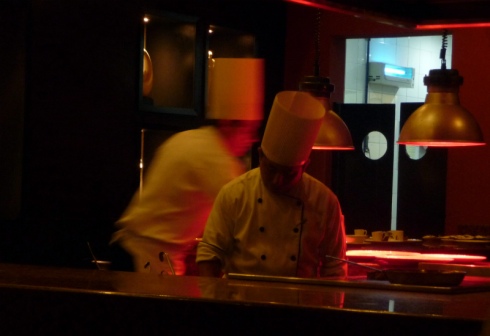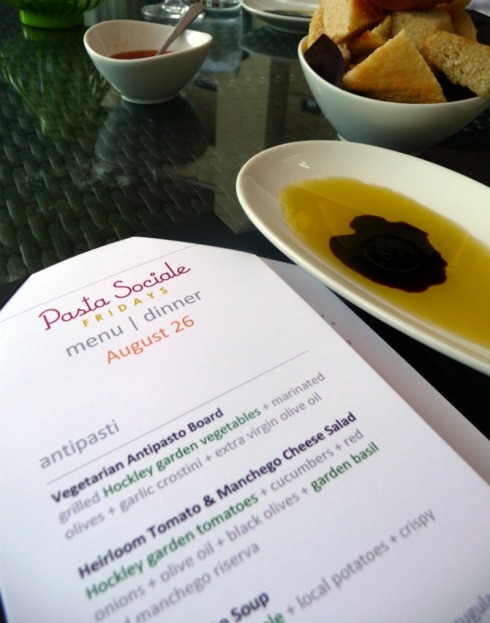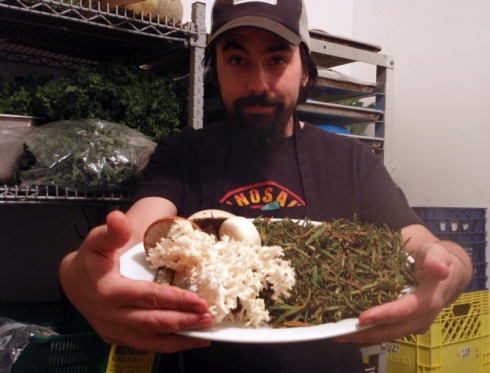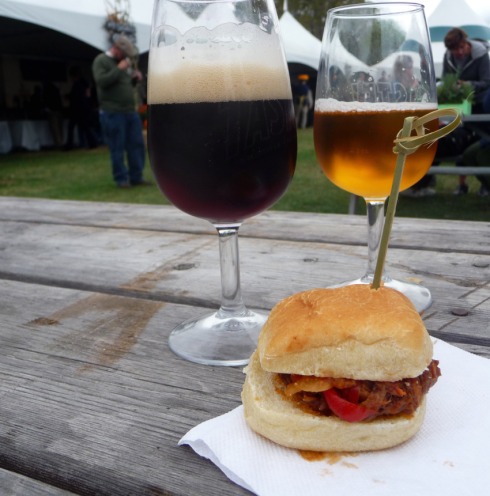
Neil and I are storytellers by nature. With his journalism background and mine in television, we share a soft spot for a good, inspiring and relatable story. We love talking to people and discovering what makes them tick, and we take personal inspiration from people who are doing amazing things, especially in the food industry.
And so, what was supposed to be a quick overnight visit to Prince Edward County to experience “Taste!” turned into a lovely weekend full of pleasant surprises, both for our palates and the storytellers in us. It felt like everywhere we went, every corner we turned, we found the most interesting people, the most surprisingly delicious food and some real County hospitality.
This was particularly apparent in our experience dining and staying over at Angéline’s restaurant and inn in Bloomfield. It’s a beautiful, quirky (in all the right ways) and charming place where the food itself has just as much of a story as the young owners who have transformed it over the last three years.
At 24 and 21, siblings Alexandre and Melanie Fida may be the youngest people in the county to own a restaurant and inn, but what they’ve managed to accomplish with their new incarnation of Angéline’s is truly amazing.

Alexandre & Melanie
Twenty-three years ago, Alexandre and Melanie’s parents moved to Ontario from Switzerland and searched for a place to open a restaurant. They ended up in Bloomfield and saw the potential that the area had, even though there wasn’t a ton going on there at the time. It was hardly the destination it’s now become. Their chef-father, Willi Fida, wanted to open a high-end restaurant that offered a true culinary experience, even when there wasn’t anything else like it to be found in the area. So, they transformed a run-down Victorian house, using the main level for the restaurant and moving their family into the rooms upstairs. On the property right next to the main house was a small motel with a few cozy rooms, which became the inn. Alexandre and Melanie literally grew up at Angéline’s (whose name is actually taken from the original owner of the property) and watched the area change over time, with their father bringing inspiration to people across the County – especially food producers.
As Alexandre told us, “My dad was really very talented. He stayed true to what he believed in. When we first moved here, he would work with the farmers. No one knew what an endive was, so he talked to them and encouraged them to grow them. With time, the farmers began expanding on the produce they grew; at the time it was very focused on potatoes and carrots. Locally, he’s kind of known as the granddaddy of fine dining in this area.” Pretty impressive, given the reputation the County now has for quality, locally-produced food and wine.
Neil and I spoke to Alexandre for a long time, mesmerized by how intelligent, well spoken and open he was about his story and the history of Angéline’s. He and his sister didn’t originally plan to take over and transform the restaurant and inn at such an early stage in their lives. But when their father suddenly passed away in a tragic car accident in 2007, everything changed for them and they had a decision to make; keep what they knew and had grown up with, or let go and start fresh, breathing new life into a place that their parents had built over two decades.
After the community pulled together to help them get back on their feet, they chose the latter path. They decided to reinvent while still staying true to their father’s legacy. Neither of them have a formal education in hospitality, but they grew up surrounded by it. Their mother, Monika, was a teacher of hospitality in Geneva and had run the place for so many years, so they knew they had a good foundation.
It took them a few years to really make it their own. But they have since transformed the Inn itself as well as the restaurant’s menu, maintaining their father’s core values of using local, fresh ingredients and keeping everything as pure as possible, but also injecting a fresh take and a younger feel.
The restaurant under Willi Fida was very classic French right down to the way that things were plated. Alexandre and Melanie didn’t want to lose that completely, but they did want the menu to feel more playful and inventive. So they put an ad online looking for a new chef, and in a stroke of fateful luck, Executive Chef Sébastien Schwab “found them”, according to Alexandre. The fact that he was French-trained, and that he liked having fun with presentation and ‘playing’ with food, made him a great fit for their new beginning.
More than just playing with the food, Alexandre took to playing with the design of the space as well. After graduating from Toronto’s Ryerson University in interior design, he saw the inn as the perfect blank slate to put his talents to work. They decided to renovate the rooms in the main house to create two suites which Alexandre carefully decorated with a mix of antiques brought over from Switzerland and modern elements that really give off a homey, comfortable and unique feel. More than that, the walls of the inn and restaurant are filled with art by local artists. Everything’s for sale, is one of a kind, and is always changing. To Alexandre, it was important to support local artists as much as local food producers, and to encourage the younger generation to keep growing and evolving the County in every way.

One of three charming dining areas



The café, where fresh coffee and croissants are served to overnight guests
The mix of old and new and the quirky elements that make the place so unique really spoke to me and our stay there was such a calming and cathartic experience. It felt special. It felt like a place that had taken a lot of care to build. We stayed in the newly renovated “Champagne Suite” in the main house and had an amazing meal at the restaurant that really embodied everything that Alexandre told us about the new concept for Angéline’s. We could taste the fresh ingredients, and we experienced the quality service and attention to detail, while still being surprised and delighted with the playful presentation of the food and interesting ingredients. The atmosphere was warm instead of stuffy, and everywhere you looked you were surrounded by art and creative elements in the design. Design complementing the food and vice versa, all together creating a full experience.

Lounge area in the Champagne Suite

Bedroom


The serene bathroom – a touch of modern amidst the antique charm
Asking questions about the art actually lead us to a visit down the road to see local artist (and server at Angéline’s!) Tammy Love’s shop, “HandWorks”. More than just her gallery, it’s an eclectic artist’s lair filled to the brim with incredible hand-made finds and stories to go along with each. Tammy will share them all with you as she charms the pants off of anyone who steps through the door, giving them her ‘spiel’ inviting them to touch everything, laugh, scream for help and just play. And that’s how it goes in the County… one story leads to another, one visit to a warm and friendly place leads you right down the road to find more of the same.
What Alexandre and Melanie have done with Angéline’s feels like just the beginning, as the County continues to grow with restaurants, wineries, art galleries and shops. And they plan to continue evolving as well, with their focus shifting to re-designing the rooms in the inn and revamping the café at the front of the restaurant. We feel so lucky to have experienced it for ourselves, but more than that, to have been invited to share in the story of the place and of the wonderful people who have brought it back to life.
Now for the fun stuff – a walk-through of our incredible meal:

Amuse Bouche: Beet Carpaccio with Avocado Oil & local herbs
The amuse of local beet carpaccio w/ avocado oil and local herbs was served with a ground cherry (my new fave!), and paired with Casa-Dea VQA Cuvee 2008, methode cuvee clos – a bubbly glass of heaven.

First Course: Trio of Soups served in a specially-designed holder
Soup #1: The most amazingly fresh corn soup we’ve ever had – it tasted like eating freshly picked corn right from the husk. The simplicity yet intensity of flavor in this soup blew us away. Made with sweet corn from Vader farms.
Soup #2: Spiced Tomato from Vicki’s Veggies. Perfectly spiced, savory and smooth. Delicious!
Soup #3: Zucchini from Hagerman Farms. Clean and simple.
 2nd Course: Seared Foie Gras on House-Made Gingerbread
2nd Course: Seared Foie Gras on House-Made Gingerbread
Pan seared foie gras with local apples flambeed in calvados, house-made gingerbread, with balsamic reduction, honey nectar and local sunflower sprouts. Seriously. This was probably even more amazing than it even sounds. It was truly so well prepared and decadent and delicious. We could have stopped after this dish and we would have been very happy. This dish was paired with Huff Estates Chardonnay 2008 VQA

3rd course: Lamb Ravioli with Sweet Pea Emulsion
Local lamb ravioli on sweet pea emulsion with sunflower sprouts and basil from the chef’s garden. This dish was paired with 2008 pinot noir county cuvee from Rosehall Run. It was beautiful and the ravioli were delicious, but the sweet pea emulsion was a little too spicy for some reason. Still, a gorgeous course and the heat didn’t stop us from polishing it off.

4th course: Coffee-encrusted Halibut with Parsnip Puree
Coffee-encrusted halibut on parsnip puree with lovage and brunoise of veggies, in a county cider emulsion. This was amazing. It inspired Neil and I to try encrusting fish in coffee sometime. Such inspired flavors! The coffee crunch on the fish was so powerful, yet not overpowering and the parsnip puree was so flavorful and creamy. We loved everything about this dish.

5th course: Trio of House-Made Desserts
Desserts in the trio: Chocolate ganache with a hazelnut feuilletine base, vanilla creme brulee & local cantaloupe sorbet. Ok, I have to admit, we dug into the dessert before even stopping to take a photo. That explains the half-eaten mess on the plate. Everything was delicious. The ganache in particular tasted very ‘Francais’, especially with the feuilletine crust (which has a finely layered and crispy texture).

Finale: Homemade Nougat
Yes, just when we thought it was all over, they brought over a little dish with pieces of glassy-looking homemade nougat that were soft and chewy and so, so good.
The wine-pairings were chosen by Alexandre himself (who is very well-versed on the wineries in the county) and each dish was described and explained to us as it came to the table. Check out the current menu for more. Angeline’s will be participating in an event called Countylicious in November where they’ll offer a special prix-fixe menu.
Tags: Angeline's, Bloomfield, Local, ontario, Prince Edward County, wine


























































